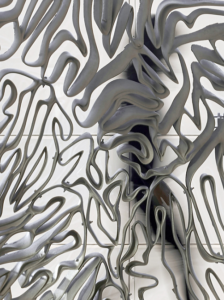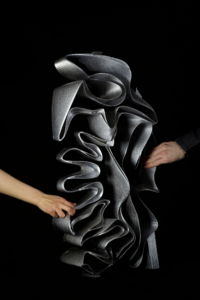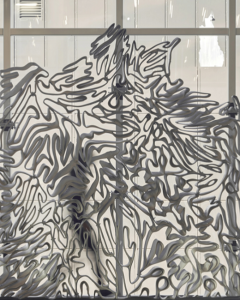 Imagine herds of fish thundering across the dusty plains, hardened fish hands sharing wild stories around a campfire, and fish rustlers sneaking into camp after dark to make off with the prize specimens. Congratulations, you have a very active imagination. But while fish farming may not have the romance that comes with nostalgic views of 19th century cow herding, it is proving to be an important method of creating the supply of food fish demanded by today’s public. Around the world, carp, tilapia, salmon, and catfish, among others, are raised in commercial fisheries composed of tanks and enclosures and requiring a great deal of human intervention in order to produce fish that are safe and satisfactory for human consumption.
Imagine herds of fish thundering across the dusty plains, hardened fish hands sharing wild stories around a campfire, and fish rustlers sneaking into camp after dark to make off with the prize specimens. Congratulations, you have a very active imagination. But while fish farming may not have the romance that comes with nostalgic views of 19th century cow herding, it is proving to be an important method of creating the supply of food fish demanded by today’s public. Around the world, carp, tilapia, salmon, and catfish, among others, are raised in commercial fisheries composed of tanks and enclosures and requiring a great deal of human intervention in order to produce fish that are safe and satisfactory for human consumption.
Fish farming comes with a whole host of its own issues, not least of which surround the area of water quality. The enclosures and tanks in which fish are commercially raised do not have the same natural balance that wild water systems inherently possess. The fact that approximately 50% of the world’s fish supply comes from these types of farming operations means that it is vital that water quality issues, such as acidity, be recognized and addressed. To that end exists Sensocore, a Singapore-based company that specializes in the production of Aquafarm automated water sensor systems, meaning systems that can send notifications so that the water quality can be monitored remotely as necessary.
Sensocore itself is a subsidiary of Camtech Diagnostics, a company that specializes in research and development projects. Through some of Camtech’s project history, a relationship had been formed with Creatz3D, the leading 3D printing solutions provider in Singapore, to deal with issues in short run and one-off production. As a result, it was not hard for Sensocore to recognize the potential that 3D printing might hold for the creation of their water sensors. After first experimenting with a consumer-grade 3D printer, it was quickly realized that the cost savings of using a consumer printer were far outweighed by the extensive investment in post-print finishing time and work stoppages caused due to issues such as warpage, intermittent extrusion, and damage to parts during the removal of support structures.
 As such, Camtech turned to the Objet Eden 260V, a commercial-grade Stratasys 3D printer employing PolyJet technology. This machine allowed them to reduce their printing time from an estimated 2 – 3 weeks to a mere 36 hours and their costs (in SGD) from $35,000 to only $3,000. It wasn’t simply the initial print that benefited from this upgrade to 3D printing. After the initial release of their sensor, customer feedback indicated that there were issues surrounding the panel buttons, which were at risk of malfunction due to exposure to the elements. Quickly creating this new part was simple, as instead of the lengthy injection mold processes traditionally used in fabrication, Sensocore was able to 3D print the new covers.
As such, Camtech turned to the Objet Eden 260V, a commercial-grade Stratasys 3D printer employing PolyJet technology. This machine allowed them to reduce their printing time from an estimated 2 – 3 weeks to a mere 36 hours and their costs (in SGD) from $35,000 to only $3,000. It wasn’t simply the initial print that benefited from this upgrade to 3D printing. After the initial release of their sensor, customer feedback indicated that there were issues surrounding the panel buttons, which were at risk of malfunction due to exposure to the elements. Quickly creating this new part was simple, as instead of the lengthy injection mold processes traditionally used in fabrication, Sensocore was able to 3D print the new covers.
 In a statement released by the company, the benefits of 3D printing to the Sensocore project were recognized:
In a statement released by the company, the benefits of 3D printing to the Sensocore project were recognized:
“With startup companies requiring to prove their products’ marketability in low volume, it made no business sense to use conventional methods. 3D printing, however, creates a new possibility as companies are no longer restricted by high costs and speed up time-to-market. Apart from short-run production, 3D printing can be used for end-use parts and manufacturing tooling.”
The ability to get products to market, have them satisfy customer quality demands, and be able to quickly respond to new needs as they arise are chief among the contributions that 3D printing has made to contemporary manufacturing. Bryan Wong, Chief Technology Officer of Sensocore, said:
“3D printing affords us better customization than traditional CNC which are not able to produce prototypes that are detailed and flexible for prototyping our product. 3D printing is the only way to go for us.”
What do you think of this news? Let us know your thoughts; join the discussion of this and other 3D printing topics at 3DPrintBoard.com or share your thoughts below.
[Images provided by Sensocore]














